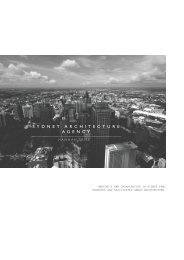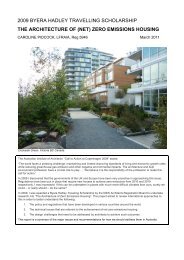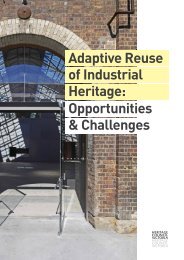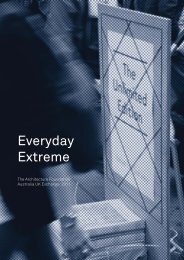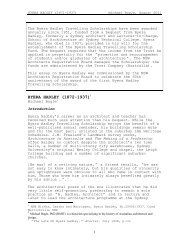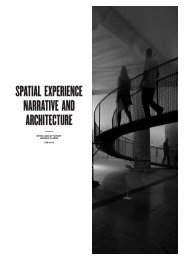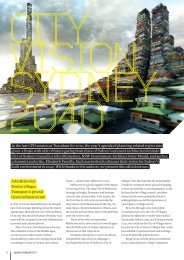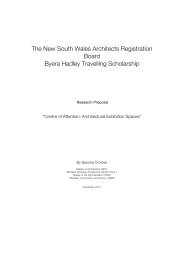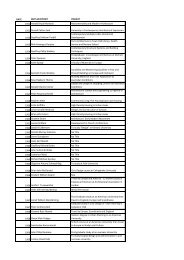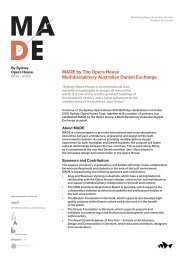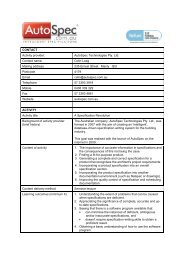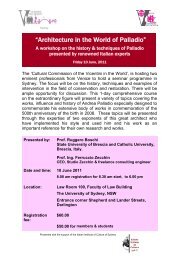4 unités LC - Architecture Insights
4 unités LC - Architecture Insights
4 unités LC - Architecture Insights
You also want an ePaper? Increase the reach of your titles
YUMPU automatically turns print PDFs into web optimized ePapers that Google loves.
Preface<br />
Observations and Visitations<br />
The subject of this thesis came about from an external study and<br />
research year in France, which took place from March 2000 to<br />
March 2001. Upon my arrival in the country, I began my search for<br />
a topic, which I had already decided would relate to the issue of<br />
social housing in France. The importance of this issue had become<br />
apparent to me during previous visits to the country, as well as<br />
through the many years that I had spent studying the language<br />
and culture. Not only have issues of Social Housing (known as<br />
HLM or HBM in France) 1 long been points of discussion for the<br />
national media due to the ‘ghetto-like’ situations many of them<br />
were found to be in, 2 but the mere impressive physical presence of<br />
these developments suggests a certain significance in itself.<br />
One of the oldest, and definitely the most famous HLM<br />
construction in France, was the ‘Unité d’habitation’ in Marseille,<br />
and although this later became privately owned, it’s origins of an<br />
HLM classification drew my interest. Knowing its age, I began to<br />
wonder what the situation and state this building was today, and<br />
whether or not it had suffered from the same problems as other<br />
more generic HLM developments in France. Through readings in<br />
various periodicals and books in search of related information and<br />
history, it came to my attention, that although a great deal had been<br />
written on the ‘Unité’ of Marseille, little had in fact been written<br />
regarding the other three constructed ‘Unités’ of Le Corbusier in<br />
France. And so began the long journey of researching, tracing,<br />
locating and visiting each of these four ‘Unités d’habitation’, filling<br />
in the missing gaps that books and journals had failed to provide.<br />
For each of the ‘Unités’ visited, at least a day was spent<br />
documenting the buildings in words, sketches and photographs,<br />
and whenever possible, the project was revisited at a different time<br />
of the year. The projects were generally visited on a weekday, when<br />
7 8<br />
businesses and schools were in activity, and if revisited, on a<br />
weekend, to note the possible differences in use by the residents.<br />
The buildings were considered not only in relation to their sites,<br />
whose states were equally studied and recorded, but also in<br />
relation to the whole surrounding area and district. Public transport<br />
was taken to each of the sites, so as to gain an understanding of<br />
the connections between each project with its surrounding district<br />
and services.<br />
The interaction between residents of the buildings with each other,<br />
as well as with residents of the surrounding area, were observed,<br />
and interviews were conducted with a variety of people. Those<br />
interviewed were of a range of professions, backgrounds, age and<br />
socio-economic standings, depending on the ‘Unité’ and its<br />
present demographic. 3 Interviews were conducted in person, on an<br />
informal basis, with each of the interviewees being addressed in<br />
their living (or working) environments. Notes from the interviews<br />
were recorded by hand.<br />
Other housing and housing related projects of Le Corbusier in<br />
France and the surrounding region were also visited with the hope<br />
of gaining a greater personal understanding for the progressive<br />
development of Le Corbusier’s ideas that eventually culminated in<br />
the ‘Unité d’habitation’ designs. The other Le Corbusier projects<br />
visited were: the Couvent Sainte-Marie-de-la-Tourette, Éveux-surl’Arbresle<br />
(near Lyon), Rhône; the Pavillon Suisse and the<br />
Pavillon du Brésil, both in the Cité Universitaire, Paris; the Cité de<br />
Refuge for the Salvation Army, Paris; Immeuble Locatif à la<br />
Molitor, Paris; and Immeuble Clarté, Geneva, Switzerland.<br />
Additional projects were unfortunately unable to be visited due to<br />
time and financial constraints. 4<br />
Information gained in these visits was equally supplemented by<br />
research carried out in various libraries around France, as well as



